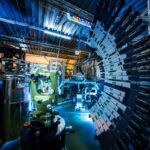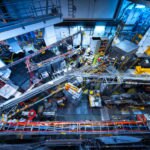Particle physics to fight cancer and pollution
The Higgs boson made the Large Hadron Collider and CERN world famous. However, the European Organization for Nuclear Research also conducts many other experiments that are less well known. Two of them – Neutron Time of Flight (n_TOF) and ISOLDE – are focused on nuclear physics and their findings could be used to treat cancer or produce safer and cleaner nuclear energy, for example.

Thousands of different types of atomic nuclei – natural and artificial as well as varying degrees of stability – emerge from combining the particles that comprise them (protons and neutrons). Studying atomic nuclei makes it possible to discover a wide range of new phenomena, explore the interactions that condition their behavior and understand their collective properties.
Last week, n_TOF Spokesperson Enrico Chiaveri and ISOLDE Scientific Director María José García Borge explained these two cutting-edge CERN projects and their future applications to the medicine and technology fields at the BBVA Foundation.
Safer and cleaner nuclear energy
According to Chiaveri, “Studying neutron induced reactions is highly important to a wide range of scientific disciplines.”
It could be used to produce nuclear energy that is safer, cleaner and easier to eliminate, for example. The experiments taking place at the CERN are applicable “to the transmutation of nuclear waste, particle accelerator systems and research on the nuclear fuel cycle.”

The Neutron Time of Flight can help to understand how the chemical elements were formed and improve medical technology. - Copyright © 2015 Andrew Richard Hara
“At the experimental stage, they are also used to treat cancer with boron,” adds Chiaveri. In this type of radiation therapy, which is still being studied for use on tumors in the head and neck, the patient is injected with a boron solution that accumulates in the cells of the tumor. The patient then receives radiation therapy with neutrons that react to the boron and destroy the cancer cells, hardly interacting with normal cells. This would reduce the side effects of radiation therapy.
The research being conducted in the Neutron Time of Flight experiment could also help with the future development and enhancement of medical technologies (MRIs, gamma ray photography). In the astrophysics field, it could also help to understand how the chemical and nuclear elements in the universe were formed.
Exotic nuclei for cancer treatments
María José García Borge explained the work underway at one of the CERN’s oldest facilities. ISOLDE, which will turn 50 in 2017, is a pioneering laboratory in the research of exotic nuclei and hosts nearly 500 scientists from around the world.
Understanding the keys to the structure, momentum and properties of these nuclei will have a positive impact on fields as diverse as astrophysics, helping to recreate the nuclear reactions that occur in the stars; on material physics, for the development of new semiconductor materials; and on biophysics and medicine. “The ISOLDE’s research focuses on producing new isotopes to diagnose cancer, for example. The idea is to use the same chemical element for diagnosis and therapy,” she explained.
More than a thousand nuclear species are available at the ISOLDE to conduct studies at the frontiers of knowledge. The new HIE-ISOLDE project, which began a year ago, expands the scientific potential of this facility even further. HIE-ISOLDE increases the intensity and acceleration energy of exotic beams, which is expected to lead to new discoveries.